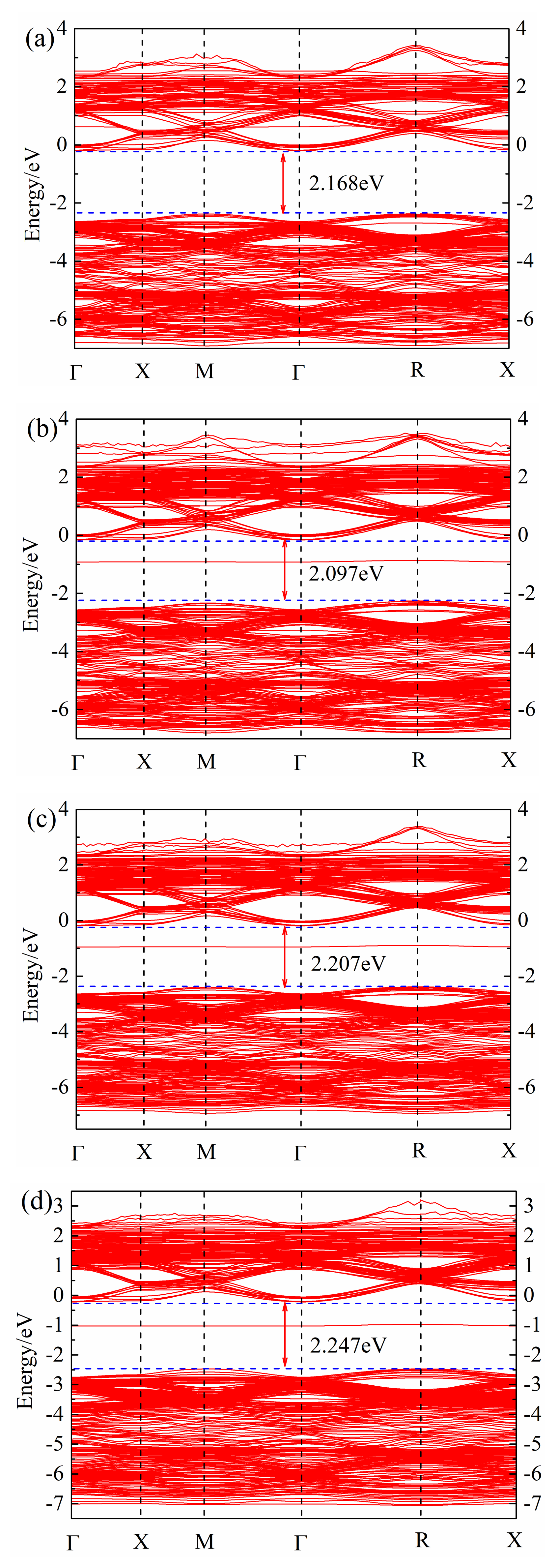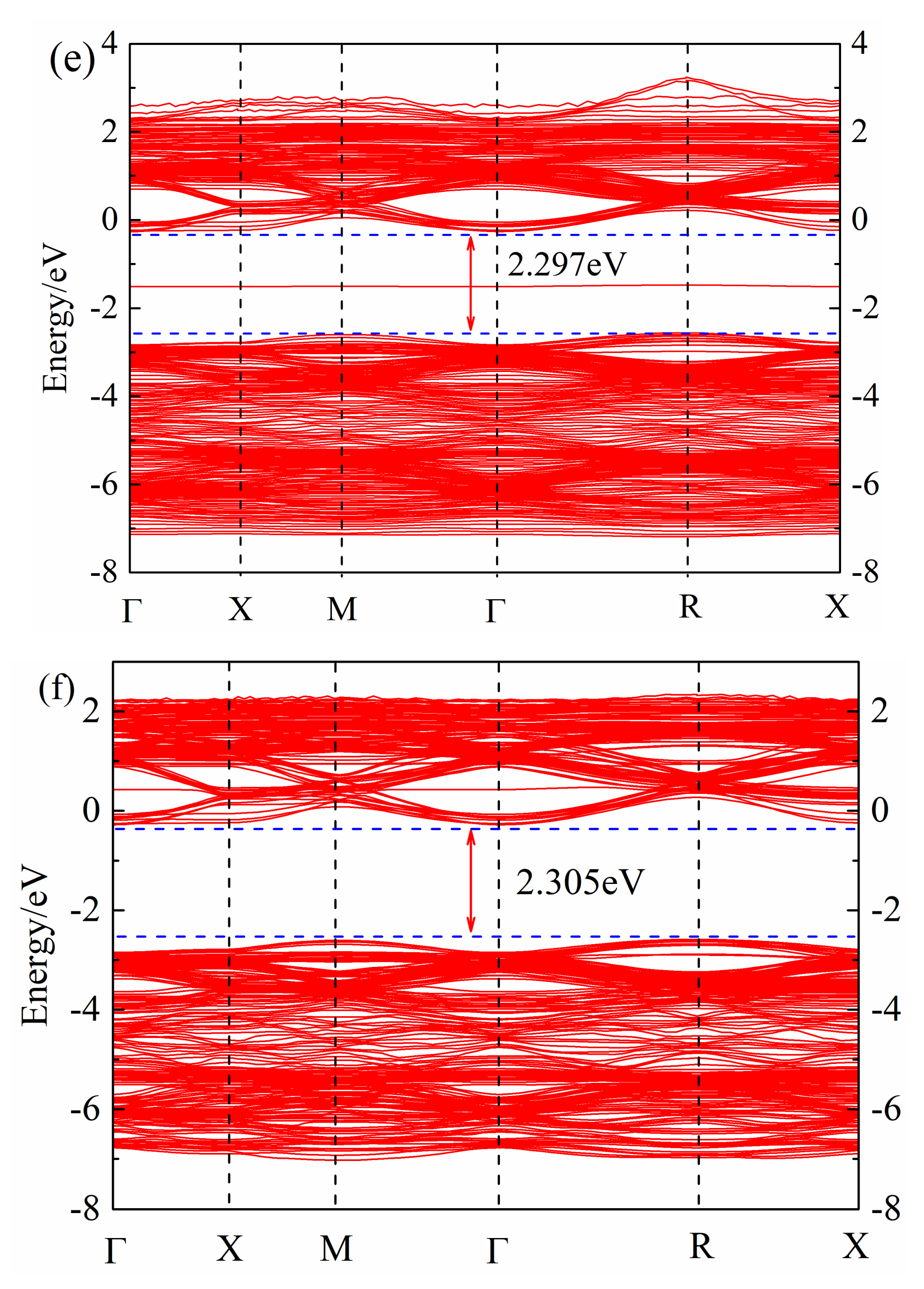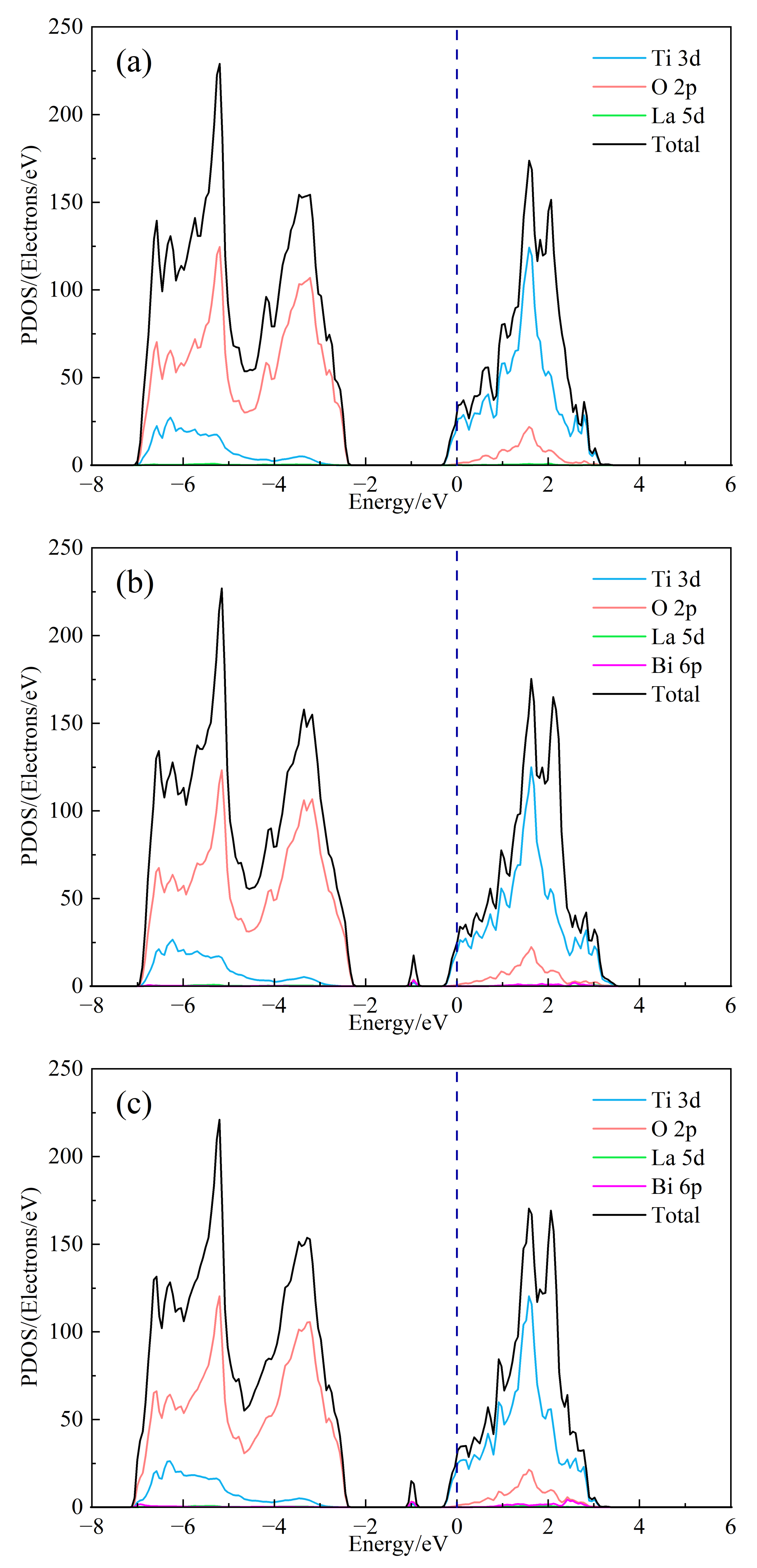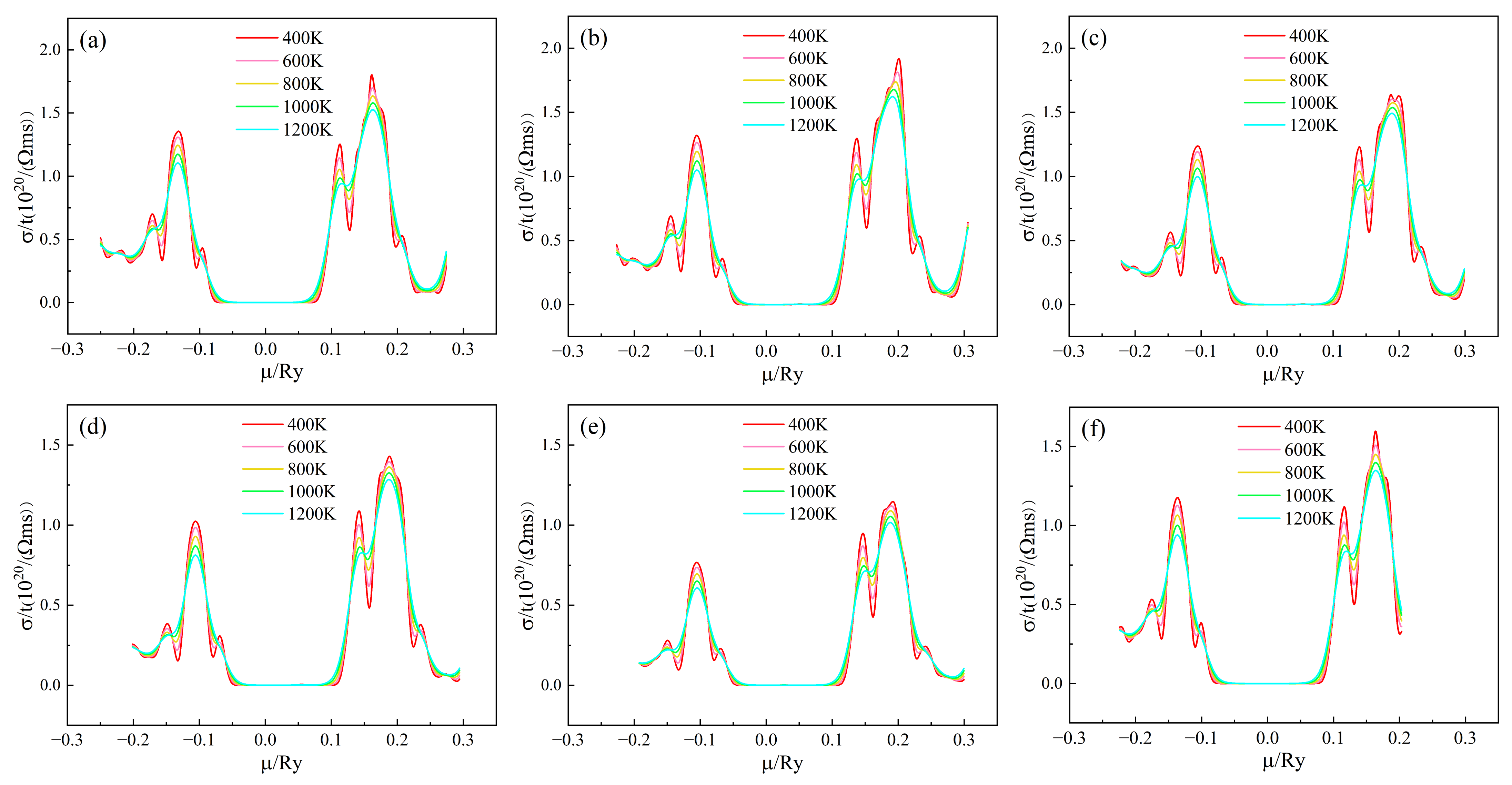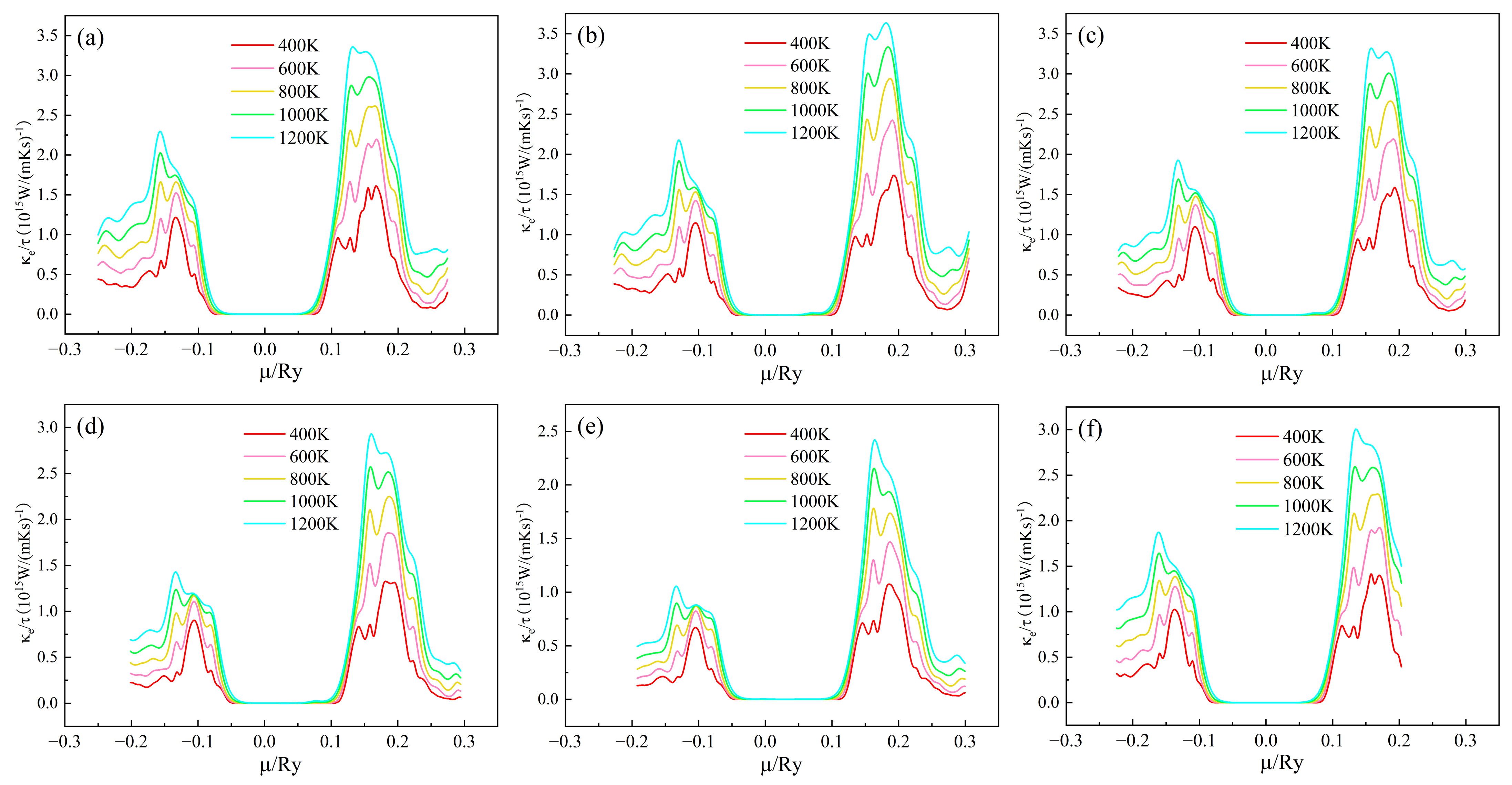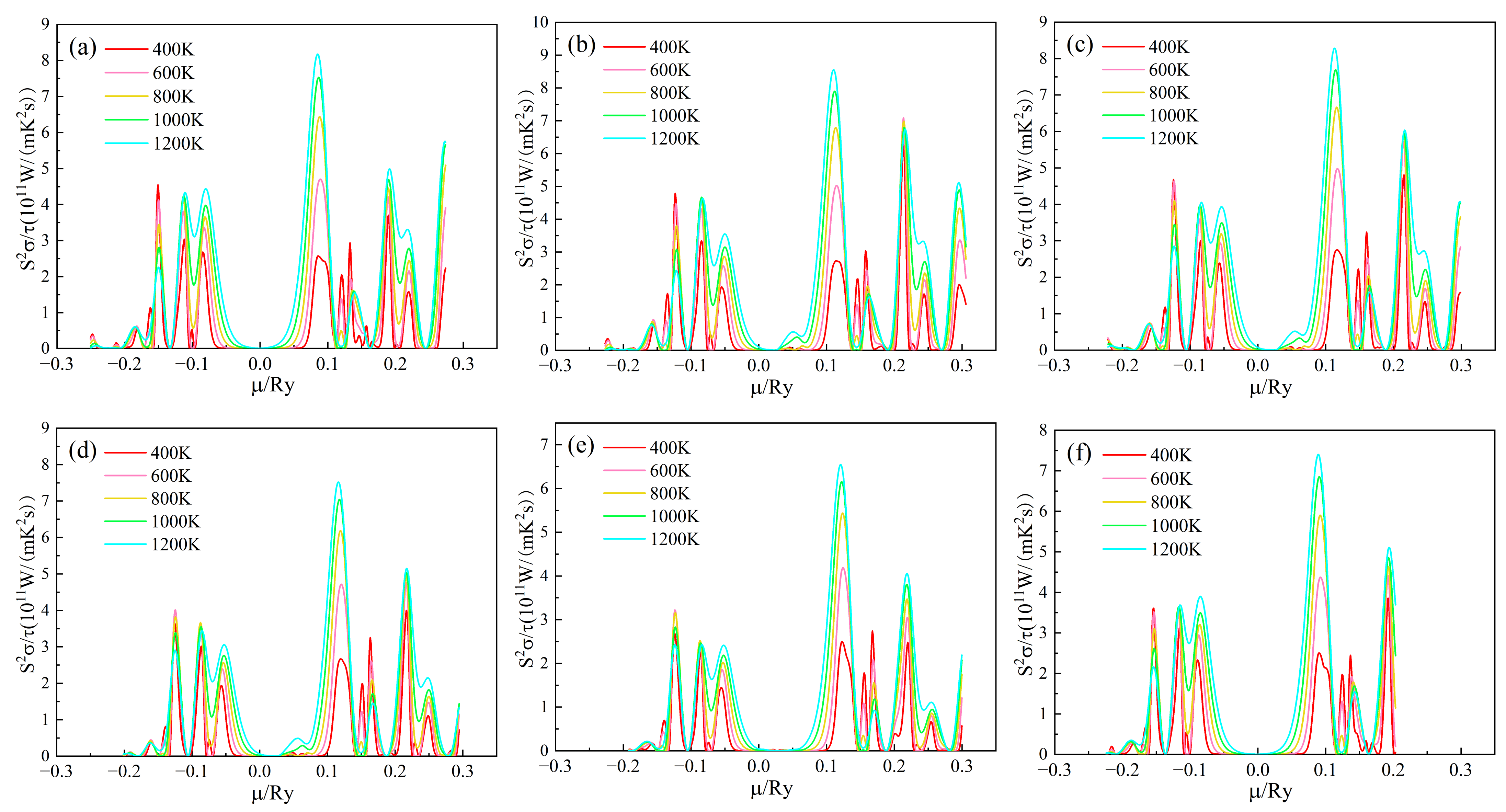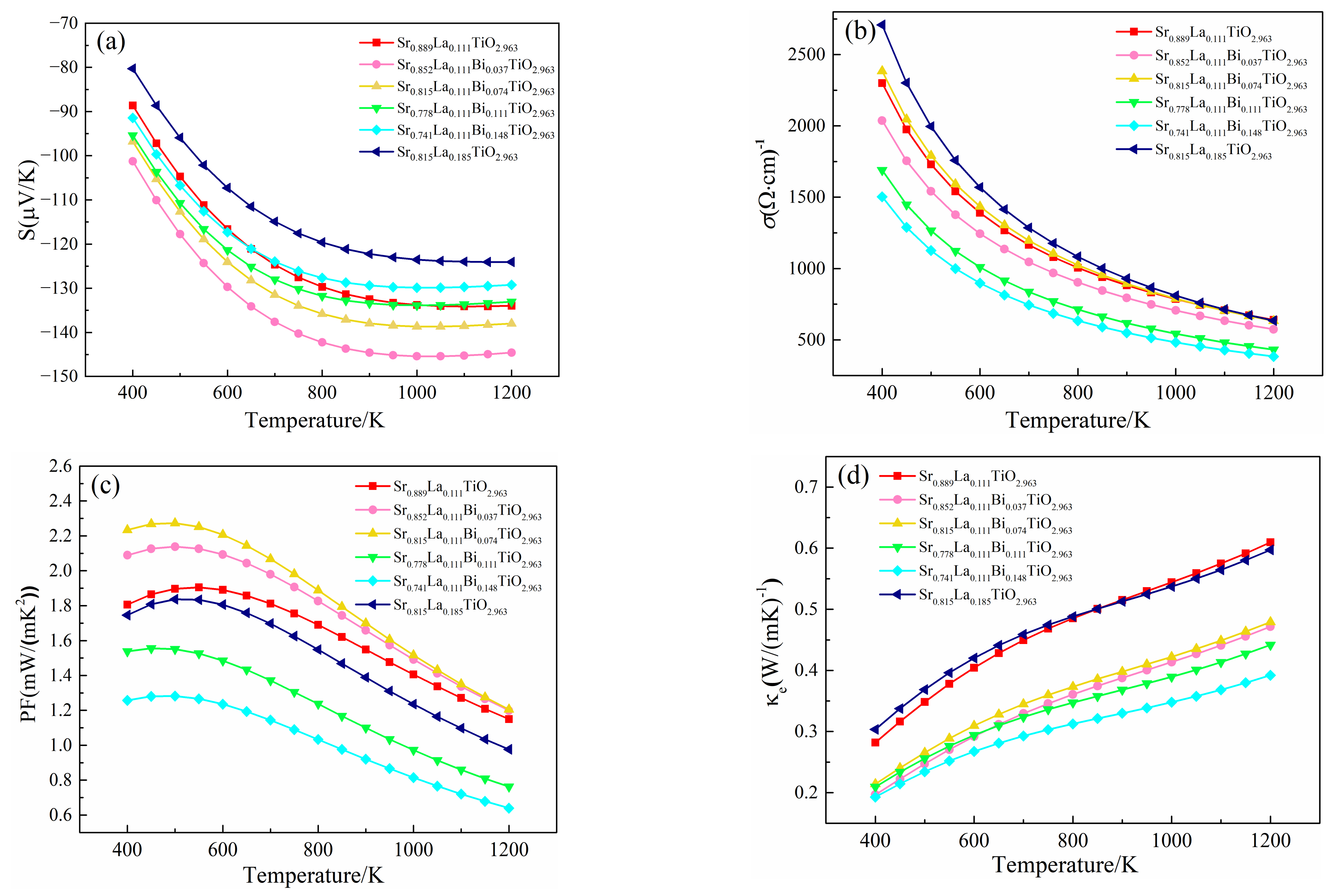3.1. Lattice Structure and Electronic Structure
Table 1 lists the cell parameters of the relaxed (Sr
0.889-xLa
0.111Bi
x)TiO
2.963 supercell. It can be seen that the calculated Sr
0.889La
0.111TiO
3 cell parameter of 0.3906 nm is −0.0512% smaller than the experimental data of 0.3908 nm [
35], which indicates that the established crystal structure model is reasonable.
It can be seen from the table that after doping Bi
3+, the cell structure of (Sr
0.889-xLa
0.111Bi
x)TiO
2.963 does not change significantly, and it still maintains the cubic system. The cell parameters in the
a and
b direction are equal, but they decrease slightly in the
c direction.
c/
a represents lattice distortion, and the more
c/
a deviates from 1.000, the greater the lattice distortion degree. It can be clearly seen from
Figure 1 that the Ti–O octahedron has an obvious distortion, and Ti
4+ ions are all far away from the center of the octahedron. In the
c direction, the atoms shift to the inside of the cell, resulting in a slight contraction of the cell. In the
a and
b directions, the atoms shift to the outside, resulting in a slight expansion of the cell. The lattice distortion degree of SLTB1-3 is similar, while the lattice distortion degree of SLT, SLTB4 and SLTL is larger.
With the increase of Bi
3+ concentration, the cell parameters increased, which is consistent with the results of another experiment [
36]. The reason for the increase of cell parameters after the introduction of Bi
3+ may be due to the mismatch and electronegativity difference between Bi
3+, La
3+ and Sr
2+, which leads to the growth of Ti–O and Bi–O bonds. The electronegativity of Bi
3+ is 2.02, the electronegativity of La
3+ is 1.1, the electronegativity of Sr
2+ is 0.95, and the electronegativity of O
2− is 3.44. According to Pauling’s rule, the larger the electronegativity difference, the stronger the electron-attracting ability of ions, the smaller the distance between ions, and the smaller the bond length. The difference between the electronegativity of Bi
3+ and that of O
2− is less than 1.7, indicating that Bi
3+ and O
2− are mainly covalent bonds, and the bond length is large. The positions of Ti1 and O1 are marked in
Figure 1a, and the positions of Bi1, La1, Sr1, O2, and O3 are marked in
Figure 1b.
Table 1 lists the bond lengths of Ti1–O1, La1–O2, Bi1–O3 and Sr1–O3 at the same position in the cell models of the six kinds of supercells. It can be seen that the Bi–O bond length is larger than the La–O bond length and Sr–O bond. At the same time, when Bi
3+ doping concentration increases, the Ti1–O1 bond length and Bi1–O3 bond length increase, resulting in cell distortion and slight expansion.
After geometric optimization, the non-self-consistent calculation of the band structure was performed, and the band structure of (Sr
0.889-xLa
0.111Bi
x)TiO
2.963 was obtained, as shown in
Figure 2. The calculation of the band structure of SrTiO
3 brillouin zone high-symmetry point selection was as follows: Γ → X → M → Γ → R → X (Γ, X, M, R, X, are the brillouin zone high-symmetry points). It can be found that the Fermi level of (Sr
0.889-xLa
0.111Bi
x)TiO
2.963 is in the top of the valence band; the band at the top of valence band is point R, and the bottom of the conduction band is in point Γ, which is consistent with Benrekia [
37]. The experimental value of the band gap of intrinsic SrTiO
3 is measured as 3.25 eV [
38], and the calculated band gap is in the range of 2.907–2.305 eV; due to the PBE function, this will significantly underestimate the band gap [
37]. Although there is a certain difference between the calculated value and the experimental value, the selected parameters in the calculation are consistent, the obtained law of band structure change is reliable and this will not affect the theoretical analysis of the electronic structure.
By comparing
Figure 2a–e, it can be seen that with the increase of Bi
3+ concentration, the band gap of ((Sr
0.889-xLa
0.111Bi
x)TiO
2.963 first decreases and then increases. The minimum band gap of SLTB1 is 2.097 eV, and the maximum band gap of SLTB4 is 2.297 eV. With the increase of the incorporation concentration of Bi
3+ ions, the deeper the Fermi level enters the conduction band, indicating that Bi
3+ ions emit more electrons than Sr
2+ ions, which increases the carrier concentration of the system and generates a degenerate system. Bi
3+ doping changes the conductivity of strontium titanate, and the Fermi level is greater than the minimum conduction band, indicating that the strontium titanate material system has exhibited metallic properties at this time [
20].
The specific defect chemical reaction can be given by Formula (1):
By comparing
Figure 2a,f and
Figure 2b–e, it can be found that impurity levels appear after Bi
3+ doping, indicating that Bi
3+ doping causes certain changes in the material energy band structure, which is consistent with the calculation of Zhang26. Bi
3+ doping introduces an impurity level at the −2 eV~0 eV position, which promotes the electron transition. Electrons can jump from the valence band to the impurity level first, and then jump into the conduction band, which will increase the electron mobility and conductivity of the material.
In order to further study the influence of Bi
3+ doping on the electronic structure of SrTiO
3, the total state density (DOS) and split-wave state density (PDOS) of (Sr
0.889-xLa
0.111Bi
x)TiO
2.963 were calculated, as shown in
Figure 3. As can be seen from
Figure 3b, the top of the valence band of doped strontium titanate is mainly composed of O-2p orbitals, and the bottom of the conduction band is mainly composed of Ti-3d orbitals, indicating that the co-vertex-connected titano-oxygen octahedron determines the electronic structure of strontium titanate, the energy level of Sr orbital does not contribute to the valence band and conduction band, and the 6p of Bi
3+ and 5d of La
3+ participate in forming the conduction band. However, its split-wave state density is small. At the same time, it is obvious that the 6p orbital of Bi
3+ introduces a small DOS peak in the center of the valence and conduction bands, which corresponds to the impurity level in the previous band structure. It is foreseeable that the inclusion of Bi
3+ will have an impact on the electrical transport performance of the material. The Seebeck coefficient is related to the asymmetry of DOS relative to the Fermi level and the steepness of state density. The larger the asymmetry, the steeper the state density peak, and the larger the Seebeck coefficient. By comparing
Figure 3a and
Figure 3b–e, the change of the value of second peak around the conduction band position of the total state density is about 2 eV, and the DOS of (Sr
0.889-xLa
0.111Bi
x)TiO
2.963 increases asymmetrically relative to the Fermi level. The introduction of Bi
3+ may increase the absolute Seebeck coefficient of the material. Under the condition of the same concentration of Sr
2+ replace, the value of the second peak of SLTB2 is less than that of SLTL, which shows that the contribution to the DOS in the bottom of the conduction band of Bi
3+ is less than La
3+ with the same concentration. As shown in
Figure 3a–e, with the increase of Bi
3+ ion incorporation concentration, the deeper the Fermi level enters the conduction band, the greater the value of DOS at Fermi level and the steeper the peak. The addition of Bi
3+ ions will increase the absolute value of the Seebeck coefficient.
3.2. Thermoelectric Properties
The Seebeck coefficient of (Sr
0.889-xLa
0.111Bi
x)TiO
2.963 changes with the chemical potential at different temperatures, as shown in
Figure 4. When the chemical potential
µ > 0, it indicates that the material is
n-type doped; when the chemical potential
µ < 0, it indicates that the material system is
p-type doped. The larger the chemical potential
µ, the deeper the Fermi level moves up into the conduction band; the smaller the chemical potential
µ, the deeper the Fermi level moves down into the valence band [
38]. It can be seen from
Figure 4a,f that the
S-curve of (Sr
1-xLa
x)TiO
2.963 is similar, and its absolute value is very large near
µ = 0, and the absolute value increases rapidly, and then increases when the chemical potential slowly decreases. When
μ < −0.1 Ry and
μ > 0.1 Ry,
S tends to zero and is almost independent of temperature, which is mainly due to the gradual decrease of carrier concentration [
24,
39]. Comparing
Figure 4a with
Figure 4b–e, it can be seen that when Bi
3+ is doped, within the range of chemical potential 0.05 Ry < µ < 0.1 Ry, the second peak appears in the Seebeck coefficient, which increases with the increase of Bi
3+-doping concentration. The possible reason for this is that the chemical potential range of 0.05 Ry < µ < 0.1 Ry corresponds to the impurity level between the top of the valence band and the bottom of the conduction band in the energy band structure. When the doping concentration of Bi
3+ increases, the energy level of the impurity increases, and the presence of impurity levels has a significant impact on the Seebeck coefficient of the material.
Figure 5 shows the conductivity/relaxation time(
σ/
τ) of (Sr
0.889-xLa
0.111Bi
x)TiO
2.963 as a function of chemical potential. In the vicinity of
μ = 0,
σ/
τ is almost 0, but mainly exhibits conductivity below −0.1 Ry and above 0.1 Ry. The
σ/
τ curves of (Sr
0.889-xLa
0.111Bi
x)TiO
2.963 have similar trends. The conductivity of
n-type doping is greater than that of
p-type doping, indicating that SLTB materials are
n-type semiconductors. When 0 <
μ < 0.1 Ry, the conductivity increases with the chemical potential. When
μ is around 0.2 Ry, the conductivity begins to decrease with the increase of chemical potential. The higher the temperature, the smaller the
σ/
τ of the material system, which is due to the severe carrier scattering at high temperature and the decrease of carrier mobility. For the (Sr
0.889-xLa
0.111Bi
x)TiO
2.963, when the Bi
3+-doping concentration is 0%, 3.7%, 7.4%, 11.1%, 14.8%, the maximum
σ/
τ of the material system is 1.802 × 10
20/(Ω·ms), 1.985 × 10
20/(Ω·ms), 1.680 × 10
20/(Ω·ms), 1.452 × 10
20/(Ω·ms), and 1.165 × 10
20/(Ω·ms) at 400 K, respectively. For the SLTL, the maximum
σ/
τ of the material system is 1.597 × 10
20/(Ω·ms) at 400 K. After the introduction of Bi
3+ doping, the
σ/
τ of the material system first increased and then decreased, indicating that an appropriate Bi
3+-doping concentration (3.7–7.4%) is conducive to the improvement of electrical conductivity, while an excessive Bi
3+-doping concentration (11.1–14.8%) will severely scatter carriers and deteriorate the conductivity.
The trend of electronic thermal conductivity/relaxation time of (Sr
0.889-xLa
0.111Bi
x)TiO
2.963 as a function of chemical potential at different temperatures is shown in
Figure 6. For (Sr
0.889-xLa
0.111Bi
x)TiO
2.963, when the Bi
3+-doping concentration is 0%, 3.7%, 7.4%, 11.1%, and 14.8%, respectively, the material system
κe/
τ maximum is 3.358 × 10
15 W/(mKs), 3.634 × 10
15 W/(mKs), 3.191 × 10
15 W/(mKs), 2.929 × 10
15 W/(mKs) and 2.420 × 10
15 W/(mKs) at 1200 K, respectively. For the SLTL, the maximum
κe/
τ is 3.006 × 10
15 W/(mKs) at 1200 K.
κe/
τ increases, and the trend of
κe/
τ is similar to
σ/
τ.
κe/
τ mainly has two peaks in the range of
μ < −0.1 Ry and
μ > 0.1 Ry.
The power factor/relaxation time of the (Sr
0.889-xLa
0.111Bi
x)TiO
2.963 varies with the chemical potential as shown in
Figure 7. The value of
S2σ/
τ of
n-type doped material is greater than that of the
p-type doped material, indicating that the material is more suitable for
n-type doping and is an
n-type semiconductor, which is consistent with the previous analysis of
σ/
τ. For the SLTB, the maximum
S2σ/
τ values of the material are 8.175 × 10
11, 8.551 × 10
11, 8.282 × 10
11, 7.518 × 10
11, 6.546 × 10
11 W/(mK
2s) at 1200 K. For SLTL, the maximum
S2σ/
τ of the material is 7.402 × 10
11 W/(mK
2s) at 1200K. The values of (Sr
0.889-xLa
0.111Bi
x)TiO
2.963 reached the highest values at 0.11007 Ry, 0.11293 Ry, 0.11685 Ry, 0.12111 Ry, 0.08539 Ry, and 0.08929 Ry, respectively. Therefore, the later calculated thermoelectric properties are based on these chemical potentials to obtain better thermoelectric properties [
24]. The variation diagram of
S2σ/
τ values of (Sr
0.889-xLa
0.111Bi
x)TiO
2.963 with the chemical potential at 1200K is shown in
Figure S1 (See Supplementary Materials). After the introduction of Bi
3+ doping, the maximum value of
S2σ/
τ of the material increases first and then decreases. When the Bi
3+ concentration is higher, the deterioration of
S2σ/
τ is more obvious. At the same time, it can be seen that the chemical potential value at which SLTB achieves the maximum S
2σ/
τ is significantly greater than that of SLTL. The possible reason for this is that with the increase of Bi
3+ concentration, the deeper the Fermi level enters the conduction band. Bi
3+ affects the band structure of the material so that the chemical potential at which the maximum value is obtained increases.
The effective mass of carriers is calculated by the parabolic model, which is mainly related to the quadratic term of the lowest conduction band [
40]. The calculated carrier effective mass of (Sr
0.889-xLa
0.111Bi
x)TiO
2.963 is shown in
Table 2. With the increase of Bi
3+ concentration, the electronic effective mass of strontium titanate material system increases slightly, from 2.422 to 2.722
me. At the same time, electron effective mass of (Sr
0.889-xLa
0.111Bi
x)TiO
2.963 is greater than that of SLT and SLTL, which is due to the larger mass of Bi
3+.
There is a relaxation time τ term in the electrical transport performance, and this paper adopts the DFT to deal with the electronic relaxation time [
33]. According to the deformation potential theory and the rigid energy band model, the relaxation time does not change with the doping concentration, and the electronic relaxation time of the three-dimensional material is shown as:
where
C3D is the elastic constant,
E is the deformation potential energy,
m* is the electronic effective mass,
kB is the Boltzmann constant,
ℏ as the Planck constant divided by 2 π,
T is temperature,
µ is the carrier mobility, and
E is the unit charge.
By applying pressure to each unit cell to cause deformations of −1.5%, −1.0%, −0.5%, 0.0%, 0.5%, 1.0%, and 1.5%, the elastic constant
C3D is calculated according to the energy–stress relationship. The deformation potential energy
E is calculated according to the energy change of the conduction band energy level, and the electron effective mass
m* is fitted according to the curve of the conduction band energy band. Finally, we substitute the parameters into the formula to obtain the relaxation time
τ of each unit cell separately, and obtain the relationship between the relaxation time and temperature. As shown in
Figure S2, when the temperature increases, the relaxation time decreases from 5.23–8.17 fs to 1.01–1.57 fs. Ohta [
10] did a similar experiment and Kinaci [
13] reported that the relaxation time of La
3+-doped strontium titanate decreases from 8 fs to 1.5 fs, which is consistent with the calculated results in this work. It shows the rationality of this method to calculate the relaxation time.
It can be found from the figure that the relaxation times of the four unit cells of SLTB1, SLTB2, SLTB3, SLTB4 are similar. The relaxation times of SLT and SLTL are slightly smaller. This is mainly due to the fact that the excessive Bi
3+ concentration reduces the deformation potential energy,
E. The calculation of deformation potential theory is based on the scattering process between phonons and electrons, without considering optical phonon scattering and possible impurity scattering, which may lead to overestimation of relaxation time, electrical conductivity, and
ZT at medium and low temperatures [
41]. However, the changing trend of the conductivity and
ZT of Bi
3+ and La
3+ doping in the high temperature section revealed in this study will not be affected.
Carrier mobility can be calculated according to the relaxation time, as shown in Formula (3). Carrier concentration can be calculated by carrier mobility and conductivity:
where
σ is conductivity,
µ is carrier mobility. The calculated carrier mobility and carrier concentration of (Sr
0.889-xLa
0.111Bi
x)TiO
2.963 are shown in
Table 2. For (Sr
0.889-xLa
0.111Bi
x)TiO
2.963, with the increase of Bi
3+ concentration, the carrier migration first increases and then decreases. When the doping concentration is 7.4%, the maximum carrier mobility is 8.937 cm
2V
−1s
−1. The high carrier mobility of SLTB2 is due to the impurity level introduced by Bi
3+ into the band structure, which acts as the carrier migration path. When the doping concentration of Bi
3+ is greater than 11.1%, the excessive mass of Bi
3+ greatly scatters the carrier, thus reducing the carrier mobility. The carrier mobility of SLTB1, SLTB2, SLTB3 and SLTB4 is similar at 8.5–9 cm
2V
−1s
−1.
What is more, with the increase of Bi
3+ concentration, the carrier concentration increases from 2.183 × 10
21 cm
−3 to 2.674 × 10
21 cm
−3. As can be seen from the defect chemical reaction equation, Bi
3+ is a +3 valence state, and when it replaces Sr
2+, it will introduce excessive electrons into the system, thus increasing the carrier concentration. Meanwhile, under the condition of the same concentration of Sr
2+, the carrier concentration of SLTB2 (2.183 × 10
21 cm
−3) is lower than that of SLTL (2.905 × 10
21 cm
−3). This may be due to the fact that the contribution of Bi
3+ to DOS at the bottom of the conduction band is smaller than that of La
3+ at the same concentration. At the same time, the carrier concentration basically does not change with temperature and is greater than 10
10 cm
−3, indicating that the material is a degenerate semiconductor [
42].
After the term of relaxation time is substituted, the Seebeck coefficient, electrical conductivity, power factor and electron thermal conductivity of (Sr
0.889-xLa
0.111Bi
x)TiO
2.963 change with temperature are shown in
Figure 8. The absolute value of Seebeck coefficient increases with the increase of temperature, from 91.428 μV/K–101.255 μV/K at 400 K to 129.225 μV/K–144.570 μV/K at 1200 K, indicating that the Bi
3+-doped SrTiO
3 material is an
n-type degenerate semiconductor. By comparing SLTB, SLT, and SLTL, the absolute value of the Seebeck coefficient of the material with Bi
3+ showed a relatively large value, which is consistent with the previous analysis of the band structure and state density. For (Sr
0.889-xLa
0.111Bi
x)TiO
2.963, the absolute value of the Seebeck coefficient ranges from 91.428 μV/K to 144.570 μV/K, which is slightly smaller than the experimental data of 95 μV/K to 175 μV/K25. With the increase in Bi
3+ concentration, although the effective electron mass of the material system increases, the Seebeck coefficient of the material decreases.
By comparing SLTB SLT and SLTL, the effective mass of electrons, carrier mobility and migration ability are increased after the introduction of Bi
3+, but the carrier concentration is reduced. Due to the conductivity equation
σ =
neµ, finally, the conductivity of (Sr
0.889-xLa
0.111Bi
x)TiO
2.963 was reduced [
39]. The electrical conductivity of SLT and SLTL at 1200 K are 640.312/(Ω·m) and 642.797/(Ω·m), respectively, which is greater than the experimental data of 250/(Ω·m)–460/(Ω·m) [
11,
12,
18]. For SLTB, with the increase of Bi
3+ concentration, the carrier concentration of the material increases, the carrier mobility decreases, and the conductivity of the material first increases and then decreases. The material with a Bi
3+-doping concentration of 7.4% obtained the maximum conductivity value (633.015/(Ω·m)). However, when the Bi
3+concentration continues to increase, the carrier mobility decreases significantly. When Bi
3+ concentration is 14.8%, the value of electrical conductivity moves down to 383.179/(Ω·m).
The reason why the conductivity of the material system is relatively high at room temperature is that the calculation considers the full excitation of electrons instead of the scattering of optical phonons and possible impurity. In practice, electrons can only gradually achieve thermal excitation when the temperature rises. So, the conductivity of the material at room temperature is overestimated [
41].
By comparing SLTB and SLT, the power factor of SLTB1 and SLTB2 is higher than that of SLT. However, when the Bi
3+ concentration is 11.1% and 14.8%, the power factor of (Sr
0.889-xLa
0.111Bi
x)TiO
2.963 decreases sharply, indicating that an appropriate Bi
3+ concentration (3.7–7.4%) is beneficial to optimize the power factor of the material. The power factors of SLTB were 1.199 mW/(mK
2), 1.205 mW/(mK
2), 0.762 mW/(mK
2), and 0.639 mW/(mK
2) at 1200 K, which is consistent with the experimental data of 0.5 mW/(mK
2)–0.9 mW/(mK
2) [
25,
36].
Thermal conductivity refers to the heat transferred by phonon transport in a temperature gradient. The main factors affecting it include average relative atomic mass, Young’s modulus, density, defects in the crystal and porosity. For the most perfect electrical-insulating materials, the heat transfer is mainly performed by phonon–phonon scattering. Combined with sound velocity and elastic properties, the lattice thermal conductivity of materials can be calculated. Slack derived the quantitative expression of intrinsic lattice thermal conductivity [
32]:
where
A is constant,
A = 3.04 × 10
7 W·mol/kg/m
2/K
3,
M is the average atomic mass,
n is the number of atoms in primitive cells,
δ is average atomic volume,
γ is Gruneisen parameters, including gamma sigma calculated by Poisson’s ratio 24, and
ΘD is the Debye temperature.
σ and
ΘD are calculated by the mechanical properties with first principles; the detailed data are shown in
Table S1.
Due to the scattering of acoustic phonons with the increase of temperature, the relationship between thermal conductivity and temperature in the experiment is often expressed as
κ =
A/
T +
LσT, where
A/
T and
LσT are respectively the thermal conductivity of lattices and the thermal conductivity of electrons [
43]. The electronic thermal conductivity has been substituted into the relaxation time term, and the calculated relation of electron thermal conductivity with temperature is shown in
Figure 8d. The electron thermal conductivity of SLTB is smaller than that of SLT and SLTL. At present, a lot of research on the lattice thermal conductivity of La
3+-doped SrTiO
3 materials in the experiment have been reported [
4,
5,
6,
7,
8,
9,
10,
11,
12]. The lattice thermal conductivity of Sr
0.9La
0.1TiO
3 at 1073K is within the trend range of 2.0–2.6 W/m·K, and the relationship between the lattice thermal conductivity of Sr
0.9La
0.1TiO
3 and temperature is as follows:
κl = 2860.0/
T. The detailed fitting process is seen in the
Supplementary Materials. Finally, the variation of lattice thermal conductivity with temperature calculated by combining experimental data with Slack model is shown in
Figure 8e.
The lattice thermal conductivity of SLT, SLTB1, SLTB2, SLTB3, SLTB4 and SLTL at 1200 K are 2.454 W/m·K, 3.465 W/m·K, 2.594 W/m·K, 2.383 W/m·K, 2.686 W/m·K and 2.516 W/m·K, respectively. It can be seen that the lattice thermal conductivities of SLT, SLTB2, SLTB3, SLTB4 and SLTL are similar, except for SLTB1 with a larger lattice thermal conductivity. When the temperature is 1200 K, the lowest lattice thermal conductivity is 2.383 W/m·K for SLTB3.
κl is related to lattice distortion [
44], a phonon-scattering effect by Bi
3+ [
45] and the average mass of lattice atoms [
32]. The larger the lattice distortion is, the smaller the lattice symmetry is. The strain field fluctuation leads to lattice relaxation, which slows down the propagation speed of phonons and inhibits the
κl [
44]. Meanwhile, due to the mass difference between the doped ions Bi
3+ and Sr
2+, the phonon scattering is enhanced, thus reducing the lattice thermal conductivity [
45]. However, a lager average mass of lattice atoms lead to higher
κl [
32]. From
Table 1, the lattice distortion degree of SLT is larger than SLTB1. Therefore, despite the presence of a phonon-scattering effect by Bi
3+,
κl of SLTB1 increases. When Bi
3+-doping concentration increases to 7.4–11.1%, the Ti–O bond length and Bi–O bond length both increase, the lattice distortion degree increases, and the phonon-scattering effect of Bi
3+ ion increases, so
κl decreases.
κl is the lowest when Bi
3+-doping concentration is 11.1%. When the Bi
3+-doping concentration is further increased to 14.8%, the heavier Bi
3+ ions greatly increase the average atomic mass of the cell, as shown in
Table S2. Despite the enhanced lattice distortion and phonon scattering, the bigger average mass of lattice atoms lead to higher
κl of SLTB4 than that of SLTB3.
The total thermal conductivity of (Sr
0.889-xLa
0.111Bi
x)TiO
2.963 is shown in
Figure 8f. The trends of total thermal conductivity and lattice thermal conductivity are basically identical. The total thermal conductivity of SLT, SLTB2, SLTB3, SLTB4 and SLTL is similar except for SLTB1 with a larger total thermal conductivity. Due to the enhanced phonon scattering at high temperature, the total thermal conductivity decreases with increasing temperature, ranging from 7.4–10.6 W/m·K at room temperature to 2.8–3.9 W/m·K at 1200 K, which is consistent with the reported data of 8.2 W/m·K at 373 K to 2.5 W/m·K at 973 K [
36].
Figure 8g shows the
ZT of (Sr
0.889-xLa
0.111Bi
x)TiO
2.963 as a function of temperature. The
ZT of SLTB increases with temperature from 0.06–0.11 (400 K) to 0.25–0.48 (1200 K). The
ZT of SLT and SLTL increased from 0.09–0.10 (400 K) to 0.37–0.46 (1200 K). When the Bi
3+ concentration is 7.4%, the maximum
ZT value is 0.48 for SLTB2 at 1200 K. However, except for SLTB2, the
ZT values of SLTB are all smaller than that of SLT and SLTL. When the Bi
3+ concentration is 14.8%, the
ZT value decreases to 0.25.
The results of thermoelectric calculation show that only an appropriate Bi3+-doping concentration (7.4%) can optimize the thermoelectric properties of materials. A smaller Bi3+ concentration (3.7–7.4%) can increase the Seebeck coefficient of the material and thus have a larger power factor, but its thermal conductivity is higher. Although a larger Bi3+-doping concentration (11.1–14.8%) will reduce the thermal conductivity of the material, it will significantly deteriorate the electrical conductivity of the material, resulting in a lower ZT. Therefore, the Bi3+-doping concentration could be 7.4%, which is best for practical preparation of the real materials and applications. In the future, more suitable dopants should be searched to improve the electrical transport performance of materials on the basis of reducing the thermal conductivity of materials, so as to obtain excellent thermoelectric performance.

